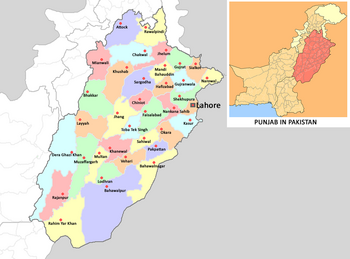Jhelum
- For the river see Jhelam River

Jhelum (Hindi: झेलम, Urdu, Punjabi: جہلم) ,Greek: Alexandria Bucephalous) is a city and district on the right bank of the Jhelum River, in the north of Punjab province, Pakistan.
Variants
- Jhelam River (झेलम नदी) (AS, p.378)
Jat clans in Jhelum District
According to 1911 census, the following were the principal Muslim Jat clans in Jhelum District[1]:
Chadhar (601), Dhamial (4,370), Dhudhi (526), Gangal (1,049), Ghogha (710), Gondal (6,549), Gujjral (788), Hariar (579), Haral (500), Jandral (618), Jangal (572), Jhammat (1,471), Jatal (710), Kalial (3,039), Kanial (2,603), Khanda (734), Khangar (1,146), Khatarmal (1,184), Khokhar (603), Khoti (646), Manhas (457), Matial (1,147), Mekan (1,229), Mogial (1,830), Phaphra (663), Serwal (572), Sial (1,125), Tama (617), Tarar (745), Thathaal (1,230) and, Raya (1,790).
History
The Janjua Jats, who now hold the Salt Range and its northern plateau respectively, appear to have been the earliest inhabitants of Jhelum. [2] The history of Jhelum dates back to the semi-mythical period of the Mahabharata. Hindu tradition represents the nearby Salt Range as the refuge of the five Pandava brothers during the period of their exile. The next major point in the history of the district was the Battle of the Hydaspes between Alexander the Great and the local ruler, Porus.
The Gakhars appear to represent an early wave of conquerors from the west, and who still inhabit a large tract in the east of the district; while the Awans, who now cluster in the western plain, are apparently later invaders, the Gakhars were the dominant race during the early Muslim era and they long continued to retain their independence, both in Jhelum itself and in the neighbouring district of Rawalpindi. During the Mughal dynasty, the Gakhar chieftains were among the most prosperous and loyal vassals of the house of Babar, but after the collapse of the Mughal empire, Jhelum came under the rule of the Sikhs. [3]
In 1765 Gujar Singh defeated the last independent Gakhar chief, Muqarrrab Khan, and subjugated the wild mountaineers of the Salt Range and the Murree Hills. His son succeeded to his dominions until 1810, when it fell to Ranjit Singh. Under the rule of Ranjit Singh, the dominant classes of Jhelum suffered much from fiscal actions; and the Janjua, Gakhars, and Awan families gradually lost their landed estates to their Jat dependents. [4]
In 1849 Jhelum passed with the rest of the Sikh territories to the British. Ranjit Singh, however, had so thoroughly subjugated the wild mountain tribes of the district that little difficulty was experienced in reducing it to working order. In 1857 the 14th Native Infantry stationed at Jhelum town mutinied, and made a vigorous defence against a force sent from Rawalpindi to disarm them, but decamped on the night following the action, with the main body being subsequently arrested by the Kashmiri authorities, into whose territory they had escaped.
Notable persons
External links
Back to Jat Places in Pakistan
- ↑ Census Of India 1911 Volume xiv Punjab Part 2 by Pandit Narikishan Kaul
- ↑ Jhelum District Imperial Gazetteer of India, v. 14, p. 152
- ↑ Jhelum District Imperial Gazetteer of India, v. 14, p. 152
- ↑ Jhelum District Imperial Gazetteer of India, v. 14, p. 152

